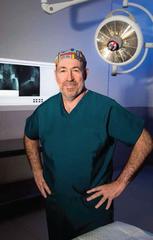Regenerative Medicine-Stem Cells & PRP
Considering Regenerative Medicine? Do Not Get Fooled!
What are Stem Cells?
This buzz word is used by a lot of companies, products, and some doctors without really knowledge or understanding what they really are. First, every single person in the world has stem cells in their bodies. They are the cells that we form everyday that have the potential to become any cell in your body; wether it be muscle, nerve, cartilage, or tissue. They are called mesenchymal cells that are cells that do not know what to do or become yet. They are sent by your body to areas that are damaged or regenerating. For example, when a muscle tears the cells that are stem cells go to the area and then help heal in part by changing into muscles cells and replace the damaged ones. This is a simple explanation of the entire complex problem of cell regeneration but these cells play a big part in healing and repair of your body.
This buzz word is used by a lot of companies, products, and some doctors without really knowledge or understanding what they really are. First, every single person in the world has stem cells in their bodies. They are the cells that we form everyday that have the potential to become any cell in your body; wether it be muscle, nerve, cartilage, or tissue. They are called mesenchymal cells that are cells that do not know what to do or become yet. They are sent by your body to areas that are damaged or regenerating. For example, when a muscle tears the cells that are stem cells go to the area and then help heal in part by changing into muscles cells and replace the damaged ones. This is a simple explanation of the entire complex problem of cell regeneration but these cells play a big part in healing and repair of your body.
The science of stem cells has been around for some time now, but now more is available to the public. There are centers across the country who are willing to do this procedure, however insurance does not currently cover the use of stem cells as the FDA has not approved wide scale use. This leads to unregulated use and its significantly high cost.
The Dallas Limb Restoration Center has utilized stem cell therapy sparingly because of the cost to our patients. These are the most expensive regenerative products available and cost a few thousand dollars normally, especially in the form of bone graft materials sold by companies claiming they contain stem cells in them. Stem cells are the most commonly used by non surgeons for profit charging thousands of dollars per injection.
Do Stem Cells Work?
Yes, stem cells appear to provide a benefit in all areas of the body especially in wound healing, inflammation, tendinitis, and possibly cartilage and bone in any joint of the body. Here at the center its been used in selective cases of mild osteoarthritis of the knees and most encouraging these patients showed no progression of arthritis on follow up x-rays. We have also used it for bone healing and muscle tears with good results.
Where Do You Get Stem Cells From?
The two most common areas to harvest stem cells are in bone and fat cells. These cells are harvested from your body, processed by a technique that isolates the best cells, and then injected where you need them. The best cells are in your blood and are better concentrated then fat cells. Also, stem cells from different areas of your body are not all the same and may not have same healing potential. Even though stem cells from bone seem to work best their is a limitation as this requires a needle to be put in your bone. This is a painful procedure because it is harvested like a marrow transplant. When harvesting bone stem cells we perform this procedure under sedation and then inject into the necessary area.
What are Limitations?
As we age there are fewer of these cells, after age 50 most of our cells in the blood are in the pelvic bones and lower spine. We also do not know what is the age limitations of this technique. Patients over the age of 60 probably make less stem cells, we are uncertain if age is a limiting factor as the use of stem cells have not been researched extensively. It makes sense that as we age our cells do too. At the present time we do not recommend this procedure for individuals over the age of 60 as your stem cells are to old for regenerative purposes.
Are There Other Stem Cell Products?
- Yes, they are taken from donors and can have an allergic reaction in some patients.
- They are prohibitively more expensive because of the cost of processing.
- This is still an experimental field of medicine. Research the centers, products, and be ready to pay cash as these procedures are not covered by insurance.
Stem cells can work in the right circumstances but their effectiveness is overinflated with most claims being unproved and simply not true. We see countless patients in our office after they spent $5,000-$10,000 on unsuccessful stem cell treatments. If these patients would have requested stem cell therapy at our center they would not have received these injections as they had little to no chance of successful treatment. At The Dallas Limb Restoration Center our number one priority is the best interest of the patient. If you are considering stem cell therapy schedule a consulation with our office for a honest discussion on the potential effectiveness of your treatment. We have also structured our stem cell pricing to be significantly less then most facilities in Dallas-Fort Worth.
What is Platelet Rich Plasma (PRP)?
Platelet Rich Plasma (PRP) is a technique that has been used for years. Some claims have been disproven however when used in the right circumstances it can be beneficial. PRP is a simple process of taking your blood and spinning it down to remove parts of your blood that contain growth cells to promote healing. PRP has been shown to promote healing in tissue, wounds, tendinitis, bursitis, and muscle healing. There is no evidence this directly helps with advanced arthritis however it can naturally reduce inflammation. PRP has been used in rotator cuff surgery and knee arthroscopy thinking it promotes healing however multiple studies now show the benefit lies in reduced inflammation. There is also no evidence to suggest a PRP joint injection provides a benefit to those patients with arthritis. Furthermore, its more expensive then hylouronic acid injections and is not covered by the majority of insurances yet physicians and clinics promote this as an arthritis treatment simply to make money. PRP does has recognizable benefits in the treatment of achilles tendonitis or tennis elbow but not for advanced degenerative joint disease.
What is Hyaluronic Acid?
There are countless advertisements in newspapers and magazines talking about FDA approved medication for joint disease and osteoarthritis. These ads entice you with wording like “injection available to avoid having knee replacements" or "FDA approved treatment surgeons do not want you to know about.” These are all clever disguised marketing ads to get your business. Most claim they put the medicine in your knee with special x-ray or ultrasound to make sure it goes to spot you need it or do this to avoid knee surgery. The majority of this business is cash pay and it is hidden you are being up charged for using these imaging modalities.
The medication these clinics are touting has been approved for years and is given in doctors offices everyday. Your family practitioner can do this at a fraction of the cost these institutes charge. Secondly, your joint is a fluid filled space with your joint fluid bathing all areas of your knee. You can inject the medicine anywhere in your joint and it quickly mixes with your fluids and goes everywhere in your knee. Advertising they are going to put it in your knee using imaging modalities to ensure it goes exactly where you need it is simply untrue and a way to increase revenue. Also, the majority of these centers advertising the use of this medication are not run by medical doctors.
Numerous studies have been conducted on the effectiveness of these medications. They have concluded these are best used in mild to moderate arthritis and may only work in fifty percent of patients. Drug companies say it may last for six to eight months but in reality it is less and your are lucky to get months of relief. If it does work, studies show it may not work as well or as long the 2nd and 3rd time you receive injections. There are always a few people who respond favorably to any treatment, even placebos.
Lastly, five to eight percent of patients can experience an allergic reaction to these injections. These reactions cause pain, swelling, and redness. There are now longer acting medications that require one injection and not a series of three to five. These longer lasting injections contain a higher dose of the medication increasing allergic reaction upwards of 15-20%. If you are interesting in trying hyaluronic acid ask any orthopedic surgeon or your internist and they be willing to do it for much less. Research studies on these medications in medical literature such as the AAOS website and not the drug company websites.

